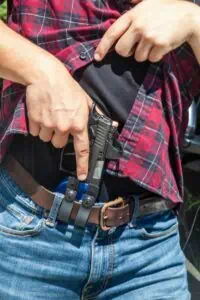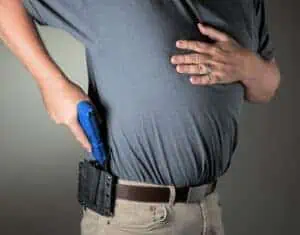Appendix Carry: The Basics
The cowboy with his gun on his hip is one of the icons of American history. We’ve come to expect that if a law enforcement officer has a gun, it’s going to be in a holster on his hip. When we compete in a practical shooting match or shoot in a pistol training class, the most common place to find a gun is in a holster on the hip. That may be changing, though. Over the past few years, there’s been a resurgence of interest in carrying a defensive pistol up front, near the belly button, in a position known as appendix inside the waistband carry, or AIWB.
First, a quick primer on how we talk about holster position on the body.
Strong Hand / Support Hand
Let’s begin by talking about which hand is which. Your strong hand is the hand you first place on your gun. It is usually the hand you write with. Your support hand is your other hand, which primarily (you guessed it) supports your pistol. Now imagine your beltline as a big clock, with 12 o’clock being where your belt buckle is. For right-handed people, strong side hip carry (the sort of thing mentioned in this article) places your holster and your gun anywhere between 3 o’clock and 4:30. Cross draw carry (where you keep your gun on the opposite hip, on your support side) means carrying at anywhere between 9 o’clock to 11 o’clock. Left-handed shooters reverse all of this.
Got it? Okay, let’s move on to talk about appendix carry/AIWB, which places your holster at around 11 to 1 o’clock on your beltline.
A Brief History of AIWB Carry
While AIWB carry may seem to be the latest, greatest thing in carrying a defensive pistol, the fact is, carrying a gun in that position has been around as long as pistols have been around. Cowboys may have carried their guns in a holster on their hip, but take a look at the photo to the right. Yes, one cowboy has a gun in a holster (a holster at about 2 o’clock, I might add) and another has his revolver jammed into his belt at 1 o’clock. Add a holster, and that cowboy is carrying AIWB.
Years passed and carry methods standardized. Police forces and militaries focused on strong side hip carry. That influence trickled down to armed citizens. The modern version of appendix carry really began because of the influence of the late Todd Green. Todd was an experienced firearms trainer who passed away due to cancer in 2016. Thanks to his efforts, appendix carry began to take off inside the firearms training world. It is now the choice for many of my friends, including Jeff Street of Step By Step Gun Training.
Advantages of Appendix Carry
Jeff mentioned his draw is quicker since he switched to appendix carry. This makes sense, as his hands don’t have to travel as far to reach his gun, resulting in a faster draw. In addition to this, it’s easier to get the gun to the beginning of the press out portion of your draw if you carry AIWB, which also makes for a faster draw.
Appendix carry also makes it easier to get to your gun if you happen to wind up in an entangled fight, rolling around on the ground with your attacker. In a close-in fight, a gun in the appendix position can be reached with either hand. A gun on your strong side hip, however, is only reachable with your strong hand. Even then it’s a dicey situation.
Other Advantages of AIWB
It’s easier and more comfortable to carry a larger gun using appendix carry. The curve of your hip makes concealing a non-curvy item like a pistol difficult to do. The front of the torso is less curvy, by and large, than your hips. That makes it easier to hide something flat and boxy, like your pistol.
Appendix carry is also uniquely suited for women. The shape of a woman’s hips are different than a man’s. That can make it difficult to conceal a gun at the 3 o’clock position. That’s not a concern with AIWB carry. I know several women firearms trainers who carry at that position.
Disadvantages of Appendix Carry
The biggest disadvantage of AIWB carry? Well, to quote Todd Louis Green, if you mess up, you die. Without proper training, there is a good chance that you’ll wind up pointing your pistol at your femoral artery as you reholster. If that happens and there is an accidental discharge, you’ve just put a round into one of your body’s largest blood vessels. That can very easily result in your death.
That’s a problem. But let’s consider it in context. Bad things can happen if you re-holster unsafely when using appendix carry, but this is true of other carry positions as well. I have seen people point their pistol inwards, towards their abdomen as they return it to a holster at the 3 o’clock position. An accidental discharge with the gun pointed across your body would have just as bad, if not worse, consequences than an accidental discharge into your femoral artery.
This disadvantage of appendix carry can be overcome with practice and altering how you re-holster your pistol after use. When I reholster a gun on my hip, I make sure that it isn’t pointed at my body as I place it back into the holster. In the same way, if you appendix carry, thrusting your hips forward as your reholster your pistol will get the important bits of your body out of the way of any potential problem.
Holsters For AIWB
Carrying AIWB requires a different style of holster than if you carry on your strong-side hip.
Your pistol is going to be pressed up against your body differently than if it was on your hip. That means features such as double belt loops aren’t as necessary when carrying at the appendix. A single point of attachment works just great with an appendix holster. For maximum retention, that attachment point should be something that completely surrounds the belt, not just a spring-loaded clip that grabs onto the belt. In addition, many appendix carry holsters have a small plastic or metal wing on the side of the holster. This wing stabilizes the holster on your belt and can make the holster more comfortable to wear.
Some specific holsters to consider for appendix carry are the Classic Holster from Phlster holsters and Dark Star Gear’s Orion and Rigel lines of holsters. These holsters are well-made, available for a variety of guns, and are specifically built to work with appendix carry.
Is Appendix Carry Right For You?
Appendix carry has some distinct advantages. However, it does require new gear and new techniques. In addition, drawing from AIWB is banned in some practical shooting disciplines such as IDPA. If you’re using practical shooting to hone your defensive carry skills, keep in mind that you might need to change to strong side carry in order to compete.
Ultimately, appendix carry is a personal choice, based on your concealed carry needs and your level of training. I can tell you, though, that AIWB carry is something that I will be investigating over the course of the upcoming year to see if it works for me. The ability to easily carry a larger gun than the 9mm S&W Shield I currently carry and the added speed on the draw make it an attractive option for me. I’m curious to see how it works.








If you use one of the so-called “bikini” tethered trigger guard holsters you can holster your gun with it pointed well forward of your body. You then put the holstered gun in your waistband, and you’re good to go, having never come anywhere near pointing at your body with an un-holstered gun.
Now show it wearing tucked in, properly fitted, business dress shirts in a professional environment. Appendix is great as long as you can dress casually, untucked or in a pullover, but if you have to look presentable all day as opposed to wearing the Gunfighter 2.0 costume (1.0 is the photog vest) it isn’t optimum. On the hip at least gets it back under the jacket.
In the video, I mention that I was switching to AIWB in the near future. Well, the future is now, and I’m starting to carry at the appendix. For business environments like you mention, I don’t like AIWB or any waistband carry, for that matter. Untucking your shirt and then getting your gun in play takes, by my count, 2/3 of a glacial epoch to accomplish. I much prefer pocket carry for any sort of business environment, at least for guys.
I wear business attire daily, and carry ccw aiwb and do not have an issue. I have a clear printing issue when I do as you suggest. If I AM wearing a blazer, it pushes it out on one side in an obvious manner that 1 o’clock appendix does not. Every body type is different….but generally, minor adaptation is all that’s necessary. For me I did have to change anything, I wore a button up, tie, and sweater vest, with or without blazer, every day regardless. Short sleeve button up in summer, sweater vest retained. The sweater vest is the perfect ccw garment for aiwb carry in a professional environment.